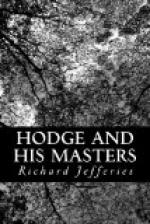A creaking and metallic rattle, as of chains, comes across the arable field—a steady gaze reveals the dim outline of a team of horses slowly dragging the plough, their shapes indistinctly seen against the hedge. A bent figure follows, and by-and-by another distinct creak and rattle, and yet a third in another direction, show that there are more teams at work, plodding to and fro. Watching their shadowy forms, suddenly the eye catches a change in the light somewhere. Over the meadow yonder the mist is illuminated; it is not sunshine, but a white light, only visible by contrast with the darker mist around. It lasts a few moments, and then moves, and appears a second time by the copse. Though hidden here, the disk of the sun must be partly visible there, and as the white light does not remain long in one place, it is evident that there is motion now in the vast mass of vapour. Looking upwards there is the faintest suspicion of the palest blue, dull and dimmed by mist, so faint that its position cannot be fixed, and the next instant it is gone again.
But the teams at plough are growing momentarily distinct—a breath of air touches the cheek, then a leaf breaks away from the bough and starts forth as if bent on a journey, but loses the impetus and sinks to the ground. Soon afterwards the beams of the sun light up a distant oak that glows in the hedge—a rich deep buff—and it stands out, clear, distinct, and beautiful, the chosen and selected one, the first to receive the ray. Rapidly the mist vanishes—disappearing rather than floating away; a circle of blue sky opens overhead, and, finally, travelling slowly, comes the sunshine over the furrows. There is a perceptible sense of warmth—the colours that start into life add to the feeling. The bare birch has no leaf to reflect it, but its white bark shines, and beyond it two great elms, the one a pale green and the other a pale yellow, stand side by side. The brake fern is dead and withered; the tip of each frond curled over downwards by the frost, but it forms a brown background to the dull green furze which is alight here and there with scattered blossom, by contrast so brilliantly yellow as to seem like flame. Polished holly leaves glisten, and a bunch of tawny fungus rears itself above the grass.




